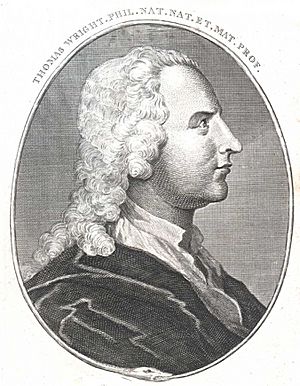Thomas Wright (astronomer) facts for kids
Thomas Wright (born September 22, 1711 – died February 25, 1786) was a very talented English person. He was an astronomer (someone who studies stars), a mathematician (someone who studies numbers), and even an architect and garden designer! He was the first person to describe what the Milky Way galaxy looks like. He also guessed that faint, cloudy patches in the sky, called nebulæ, were actually other distant galaxies.
Contents
Younger Years and Learning
Thomas Wright was born in a place called Byers Green in County Durham, England. He was the third son of John and Margaret Wright. His dad was a carpenter. Thomas learned at home for a while because he had a speech impediment, which means he had trouble speaking clearly. Later, he went to King James I Academy.
In 1725, when he was about 14, he started learning to be a clock-maker with Bryan Stobart. Even while learning this trade, he kept studying on his own. He also took classes in math and how to navigate ships at a free school. After that, he went to London to learn how to make mathematical tools. He even took a trip by sea to Amsterdam to learn more!
In 1730, Thomas opened his own school in Sunderland. There, he taught math and navigation (how to find your way, especially at sea). Later, he moved back to London to work on projects for rich people who supported his work. He traveled to Ireland in 1746-1747 and wrote a book called Louthiana. This book had drawings and plans of old monuments in County Louth. He published it in London in 1748. After this, he moved back to County Durham and built a small observatory (a building for looking at stars) at Westerton.
Thomas Wright's Astronomy Ideas
Thomas Wright wrote an important book in 1750 called An original theory or new hypothesis of the Universe. In this book, he explained why the Milky Way looks like a band of light across the sky. He said it was because we are inside a flat layer of stars, and when we look through it, it appears as a bright band.
This idea was very important and influenced another famous thinker, Immanuel Kant. Kant later wrote his own book about the universe in 1755. Thomas Wright's theory was later proven more accurately by William Herschel in 1785. This led to the idea of galactocentrism, which means the Sun is in the center of our Milky Way galaxy.
Another amazing idea from Thomas Wright, which people often also credit to Kant, was that many faint, cloudy patches in the sky, called nebulæ, were actually very distant galaxies. Wright wrote:
...the many cloudy spots, just perceivable by us, as far without our Starry regions, in which tho' visibly luminous spaces, no one star or particular constituent body can possibly be distinguished; those in all likelihood may be external creation, bordering upon the known one, too remote for even our telescopes to reach.
This means he thought those cloudy spots were other "creations" or universes, too far away for even his telescopes to see individual stars in them.
Kant called these "island universes." However, for a long time, most scientists didn't believe this idea. It wasn't until 1924 that Edwin Hubble proved that these "spiral nebulæ" were indeed distant galaxies. He did this by measuring special stars called Cepheids.
In his letters, Thomas Wright also wrote about how incredibly huge the universe might be and how peaceful eternity could be. He thought that the end of a world, or even a whole system of worlds, might be a common event in the grand scheme of nature, just like birthdays or deaths are for us on Earth.
Designing Gardens and Estates
Besides his work in astronomy, Thomas Wright was also a talented garden designer and architect. He is known for his work at Cassiobury Park in Watford for William Capel, 3rd Earl of Essex. Wright even drew his designs in books like A Walk in Cassiobury Gardens. He also taught math to the Earl's daughters. Another important person he worked for was the Earl of Halifax at Horton House.
In the 1750s, he designed the grounds of Netheravon House in Wiltshire. After 1753, he finished the design and building of Horton Hall in Northamptonshire and its gardens. In 1769, he designed a special building called a folly or "eye-catcher" known as Codger Fort at Rothley, Northumberland, which was part of the Wallington Hall estate.
One of the biggest examples of Thomas Wright's garden design work that still exists today is the Stoke Park Estate. Wright redesigned this estate between 1748 and 1766.
Later Life and Passing
Thomas Wright passed away in 1786 in Byers Green, the same place he was born. He was buried in the churchyard of St Andrew's, South Church, in Bishop Auckland. He had an illegitimate daughter who survived him.
Works
- An original theory or new hypothesis of the Universe (1750)
- Louthiana (1748)
- A Walk in Cassiobury Gardens
- Views of Cassiobury
- Grotesque Architecture (1767)
Images for kids
-
Wright's observatory/folly at Westerton, County Durham
See also
 In Spanish: Thomas Wright para niños
In Spanish: Thomas Wright para niños




